TL;DR
Open shower wet rooms feel airy and modern, but they can be cold and splash‑prone unless you plan for heat, slope, glass width, and slip resistance. Upload one photo to ReimagineHome.ai to visualize warmer layouts, tile swaps, and enclosure options in seconds before a single tile is cut. It’s the quickest path to test trending interior design styles 2025 against your real bath.
Why Open Shower Design Matters Right Now
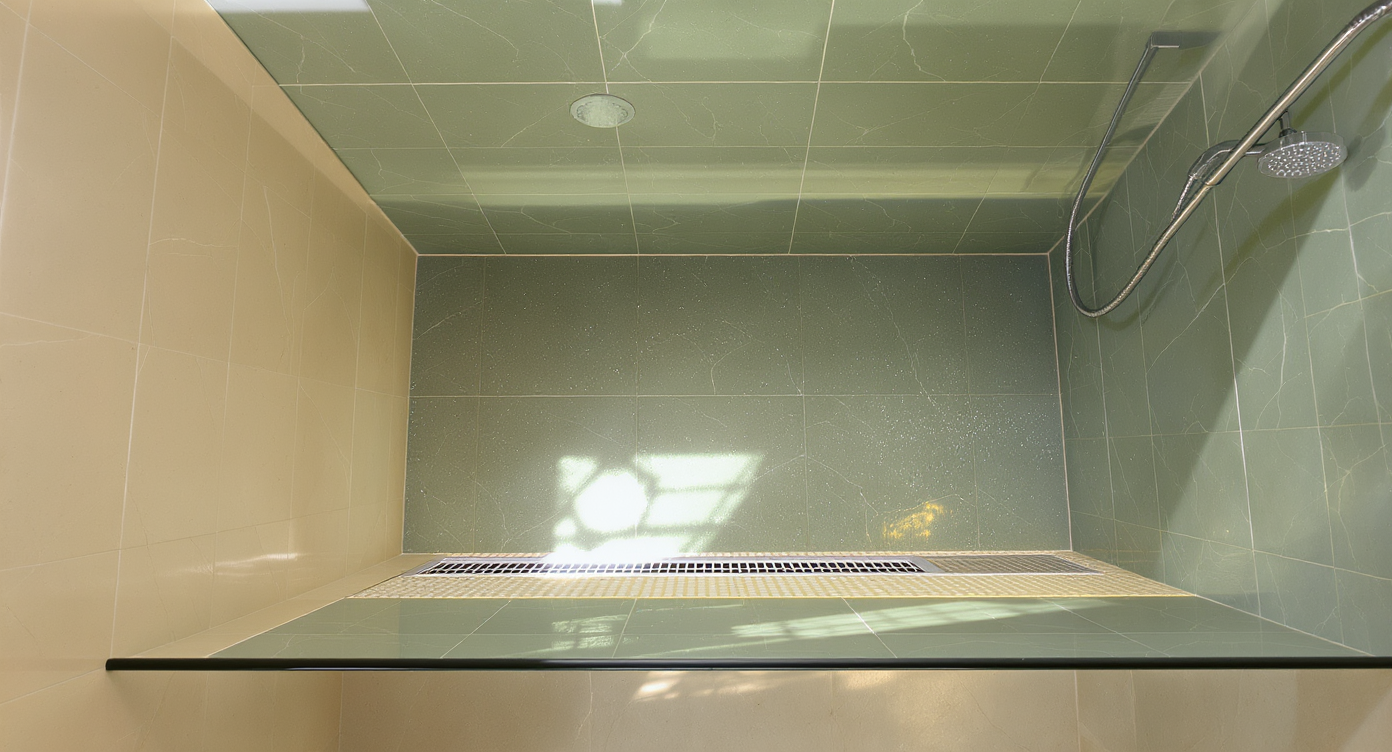
Open showers combine minimal style with smart details for warmth, splash control, and safety.
Open showers matter right now because they deliver a minimal, barrier‑free look that reads bigger, cleaner, and more spa‑like than a standard tub/shower combo. They also raise practical questions about warmth, splash control, and tile safety you should solve before installation. At a glance - Warmth first: radiant heated floors, a fan with integrated heater, and/or extending glass minimize drafts. - Splash control: proper floor slope to a linear drain, larger glass panels, and head placement manage water. - Safety: choose shower surfaces with a wet DCOF of ≥0.42 or use small mosaics (1–2 in.) for traction. - Color cohesion: pair saturated green tile with warm whites, taupe, or stone—avoid competing greens. - Future‑proofing: design glass and hardware so you can add a door later without retiling. - Drainage details: most codes target a 1/4 in. per foot (2%) slope toward the drain. - Cleaning load: fluted/reeded or ribbed wall tile adds texture but needs soft‑brush maintenance. - Privacy: zone the toilet with a half wall or offset it from the sightline. - Budget note: electric radiant mats for a mid‑size bath often total under $1,000 in materials; pro install adds more. Try it now: See warmer, safer open‑shower options in your exact bathroom with ReimagineHome.ai. Upload one photo and compare style variations in seconds. https://www.reimaginehome.ai/?utm_source=blog
What’s Driving This Design Trend (and Your Concerns)

Zero-threshold access with warm floors and splash control addresses key user concerns in open showers.
Eliminating a 4–6 inch curb creates true zero‑threshold access—one reason wet rooms continue to trend into 2025. The combination of accessibility, minimalist lines, and global style influences (Scandinavian and Japandi especially) makes open showers a modern decor staple. But three realities shape whether you’ll love daily life with one: thermal comfort, water management, and finish durability. - Thermal comfort: Radiant heated floors can lift surface temperatures to the 80–85°F range, taking the sting out of tile on winter mornings. A bath fan with a built‑in heater delivers fast spot warmth post‑shower. Extending glass to 7 feet high or closer to the ceiling reduces drafts while keeping the open look. - Water management: Plan a 2% floor pitch toward a linear drain along the far wall or entry line. Place hand‑showers and rain heads to direct spray away from openings. In tight rooms, a wider splash panel (42–48 in.) contains more mist than a narrow one. - Finish durability: Textured porcelain tile (aim for wet DCOF ≥0.42) and epoxy grout stand up to daily soaking. If you love fluted or ribbed wall tile, pair it with a smooth, slip‑resistant floor and commit to regular soft‑brush cleaning. This is where AI design tools help. With room makeover AI, you can preview glass widths, drain positions, and tile textures before committing, so your open shower reads “spa” instead of “splash zone.”
Anecdote
A couple fell for emerald shower tile but kept turning off their heated floors to “save power.” After a week of cold mornings, they set the thermostat to a low, steady 82°F. The tile felt warm, the drafts vanished behind a taller glass panel, and suddenly that bold green looked like a boutique spa, not a gym locker room.
How This Style Looks in Real Homes
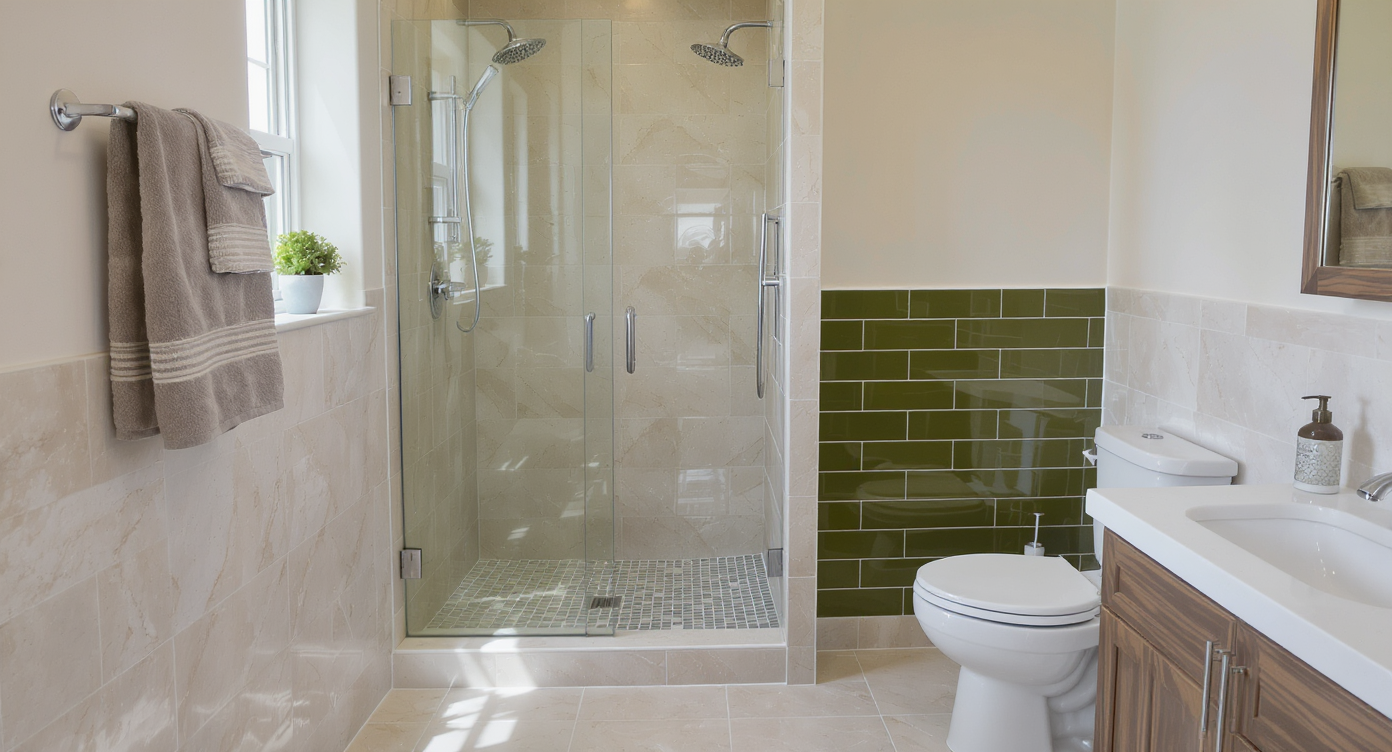
In real homes, open showers balance large tiles with textured mosaics and privacy elements for warmth and style.
Tiles labeled large‑format are typically 24×24 inches or larger, while shower‑safe mosaics run 1–2 inches for grip—mixing both balances scale and traction. In real homes, the best‑looking open showers use a restrained palette and a few high‑touch textures so the room feels calm, not chaotic. - Color palettes: If green tile is your hero, let it sing. Pair it with warm white (think cream, not stark), light taupe, or soft stone so the tile looks richer, not duller. A simple 60/30/10 ratio—60% neutral walls, 30% tile, 10% metal/wood—keeps balance. Competing paint greens often clash because undertones fight; choose contrast over “almost matching.” - Materials and shapes: Fluted tile on a niche wall or bench front adds shadow play. Honed stone or textured porcelain underfoot feels secure when wet. Brushed brass warms cooler greens; matte black sharpens beige and stone. - Layout cues: Most designers keep at least 30–36 inches of clear circulation. In small baths, a wall‑to‑wall linear drain lets you slope the whole floor gently, avoiding awkward humps. Glass that rises to 80–84 inches tall contains more steam than a low panel while staying sleek. If you’re unsure, ai interior design from photo tools let you audition paints next to your tile instantly and see how a creamy white shifts the mood versus a sage or deep green accent wall.
Modern Tools That Help You Explore This Style (and Why ReimagineHome.ai Wins)

ReimagineHome.ai’s AI tool quickly visualizes open shower styles to help you explore design options easily.
AI layout tools can generate style variations in under 10 seconds, making them ideal for testing open‑shower scenarios. Traditional mood boards convey vibe but not splash paths; floor plan apps are great for measurements but don’t show steam and spray behavior. 3D walkthrough tools help, yet they’re time‑intensive to build. Here’s where ReimagineHome.ai stands out: - Upload‑photo → instant restyle: One image is enough to try wet room layouts, alternate glass widths, or switch from large‑format tile to mosaics for grip. It’s redesign my room energy—without measurements. - Realistic surfacing: Among AI design tools, ReimagineHome.ai prioritizes material realism so you can judge texture, grout tone, and sheen in context—critical for slip‑resistant floors and fluted walls. - Style recommendation nudge: Curious whether your bath leans Scandinavian, Japandi, or Minimalist? The ai room designer lets you compare interior design style options side‑by‑side and pick what feels right. - Catalog depth: With a broad virtual catalog, you can visualize rain heads vs. handhelds, linear drains, or heated‑towel rails—useful for modern decor decisions. Explore more: - See bathroom style comparisons in our inspiration library: https://www.reimaginehome.ai/blogs/inspiration - Learn how to visualize a room makeover from one photo: https://www.reimaginehome.ai/blogs/guides/ai-interior-design-from-photo - Trend notes for 2025 bathrooms: https://www.reimaginehome.ai/blogs/trends/2025-bathroom-trends
Step-by-Step — Try This Style Using ReimagineHome.ai
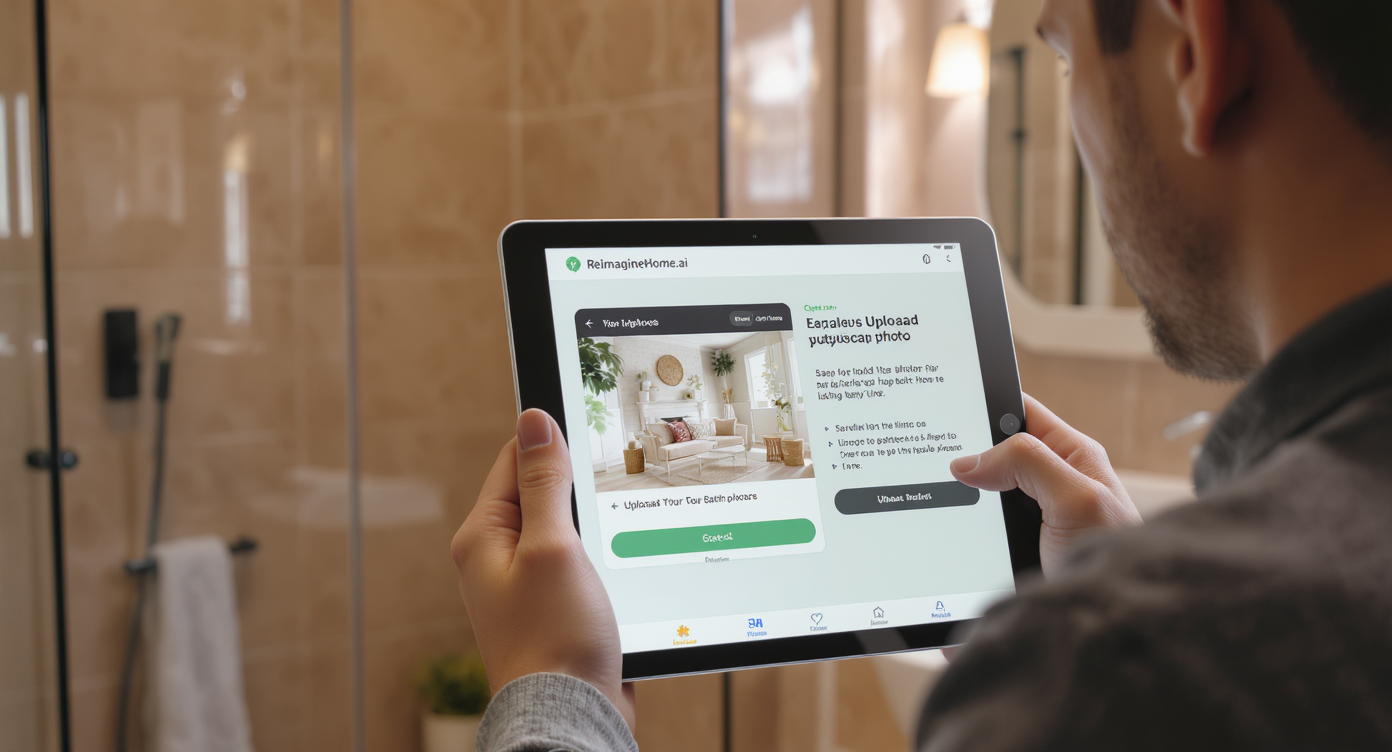
Easily try open shower styles step-by-step with ReimagineHome.ai’s intuitive photo upload and styling tools.
One photo is all you need to restyle your bathroom with AI. - Step 1: Snap your current bath straight‑on. Include the shower opening, floor, and any green tile or feature wall. - Step 2: Upload to ReimagineHome.ai and select an open‑shower/wet room preset. - Step 3: Test warmth fixes: add radiant floor, raise glass to 80–84 inches, or try a partial door. - Step 4: Swap surfaces: compare 24×24 floor tile vs. 2×2 mosaics; check wet DCOF cues in the description. - Step 5: Adjust water control: move the shower valve to the entry wall so you can turn on water without stepping in. - Step 6: Compare palettes: warm white vs. taupe walls around green tile, then save your favorites. In minutes, you’ll have multiple room makeover AI options to discuss with your contractor—before grout sets.
Visualization Scenario
Upload your current bath photo to ReimagineHome.ai, then generate two versions: Version A with a 32‑inch splash panel and cool white walls; Version B with a 48‑inch panel, radiant floors, and a cream‑taupe paint. Compare where water lands, how the light reads on tile, and which one you’d want at 6 a.m.
FAQ
- How do I keep an open shower from feeling cold? Use layered heat: radiant floors (80–85°F surface temps), a fan with a built‑in heater, and taller glass panels (around 80–84 in.). These choices reduce drafts while preserving the open look. - Will water go everywhere without a door? Not if you plan slope and spray. A 2% floor pitch to a linear drain, a wider splash panel (42–48 in.), and orienting sprays away from the opening keep water contained in most layouts. - Are large tiles too slippery for shower floors? Large tiles can be fine if they meet wet DCOF ≥0.42, but many homeowners prefer 1–2 in. mosaics for extra grout traction. You can also inlay a mosaic “landing zone” where feet plant. - Can I try this with AI from one photo, no measurements? Yes. ReimagineHome.ai supports ai interior design from photo so you can explore layouts, glass sizes, and palettes quickly, then share the images with your builder. - What wall color works with green tile? Warm whites (cream), light taupe, or soft stone hues usually enhance green tile. Avoid slightly different greens—they often clash. Test options visually with ReimagineHome.ai before you paint.
Visualize Your Style’s Next Chapter
Two minutes of AI testing can save weeks of second‑guessing later. Whether your goal is a Scandinavian‑calm wet room or a bolder, mixed‑material bath, ReimagineHome.ai lets you refine warmth, safety, and style until it feels intentional. Upload a photo, try the fixes that matter, and confidently land an interior design style that’s beautiful to see—and better to live in. https://www.reimaginehome.ai/?utm_source=blog
.svg)

.svg)

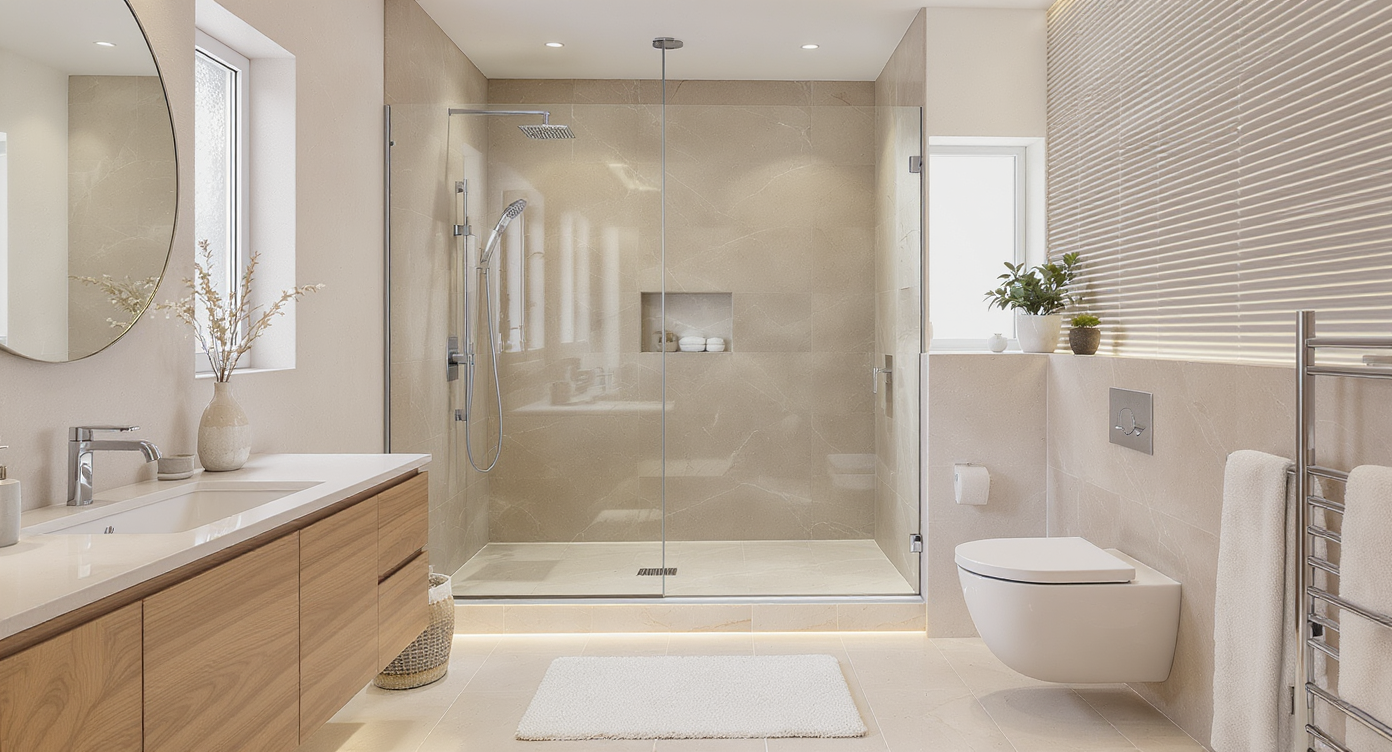





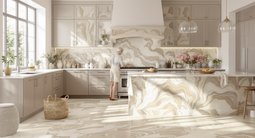






.png)